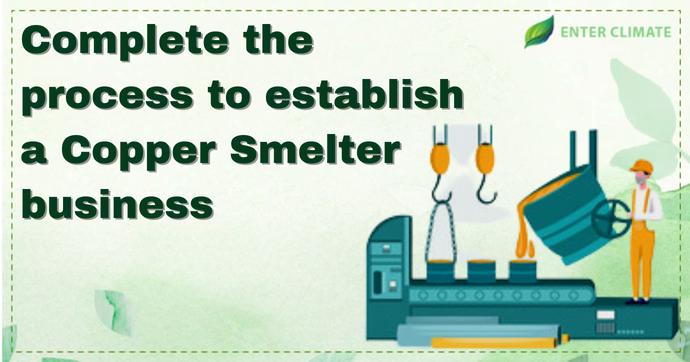Complete the process to establish a Copper Smelter business
 14 Oct, 2022
14 Oct, 2022 
Copper is one of the most used metals, which is malleable, soft and ductile with high electrical and thermal conductivity. It is reckoned amongst one of the few metals that occur in nature in a directly usable metallic form. It is a native and important non-ferrous base metal with wide industrial applications, including defence, space programmes, power cables, telecommunication cables, railways, etc. India is not self-reliant in the manufacture of copper ore. Furthermore, for the domestic manufacture of ore and concentrates, India exports concentrates for the sopper smelters business from other countries. The national quota for copper and its alloys is met through domestic production, scrap recycling and imports.
Importance of establishing a Copper Smelter Business
In the recent survey on the market demand for copper, the demand has been estimated to be 2.3 million tonnes seeing the economic growth and rise in demand for the metal. To meet future demand, the copper industry has been geared up now. The supply estimate of 2.8 million tonnes by 2024-25 will content the domestic demand in supplement to the export demand.
Overview of Copper Smelter Business in India
The Electrical/Electronic industry is the largest consumer of copper, used in the form of cables and winding wires. It is the most useful non-precious metal. Also, copper is an excellent conductor of electricity because it needs much less resistance and is harmless for electrical distribution systems, from high-voltage transmission cables to micro-circuits. Copper also has relatively high creep strength compared to other commonly used materials. Keeping these properties in mind, it won’t be wrong to say that the copper smelter business in India is anticipated to flourish at a high rate.
Semiconductor manufacturers have launched a revolutionary ‘copper chip’ in the electronic industry. Microprocessors can operate at higher speeds using less energy by using copper for circuitry in silicon chips. Copper heatsinks eliminate heat from transistors and permit computer speeds to consume less energy and processors to function at peak capability. Copper is used in construction as taps, valves, fittings, and plumbing. Along with this, copper is used in Transportation Industry as various components. According to an approximation by the International Copper Study Group, most cars contain an average of 20 kg of copper. Also, luxury and hybrid vehicles contain around 45 kg of copper. All these stats give a clear picture of the future of the copper smelter business in India.
The process used in the Copper Smelter Business
|
Sr.No. |
Steps |
Process |
|
1. |
Formulation of Copper Concentrate |
This is the first step implemented in the copper smelter business. Concentrates imported from overseas are separated into different storage bins by formulation quality. |
|
2. |
Flash smelting furnace |
The copper concentrates are transferred to the flash smelting furnace having oxygen-enriched air. CuFeS2 + SiO2 + O2 → Cu2S・FeS + 2FeO・SiO2 + SO2 + Reaction heat |
|
3. |
Converter Furnace |
After the flash smelting furnace, the matte produced during the process is transferred to the converter furnace. Cu2S・FeS + SiO2 + O2 → Cu + 2FeO・SiO2 + SO2 + Reaction heat |
|
4. |
Anode Furnace |
Butane gas is moved into the anode furnace as a reductant to eliminate the oxygen in the blister copper. |
|
5. |
Anode Casting Wheel |
The refined blister copper is cast into an anode plate for electrolytic refining. |
|
6. |
Refinery |
Refined copper in this process is achieved as a final product. |
Authorisation to establish Copper Smelter Business in India
The process for acquiring Consent NOC is directed under Air and Water Acts. CTE (Consent to Establish) is obtained by the owner of the Copper Smelter Business before the unit is established. For CTE, the smelter must register on the state department’s (State Pollution Control Board or Pollution Control Committee) official portal. He must upload the application as per Form I with the required documents. Once the authorities examine these documents, the SPCB/PCC grants the certification.
However, CTO (Consent to Operate) is attained after the copper smelter business is instituted and is ready to start manufacturing. For CTO, the procedure for getting a certificate is similar to the CTE. The business owner must register with the state authority (SPCB or PCC) on the official portal and upload the submission according to Form I with the required documents. After the authorities inspect these papers, the PCC or SPCB sends authorised personnel for the examination. The personnel, based on the inspection conducted, frames a report., The authorisation for operation is granted accordingly.
Documents required for Consent to Establish
As per the Air and Water (Prevention and Control of Pollution) Acts, for acquiring Consent to Establish from the State Pollution Control Board/Pollution Control Committee for a Copper Smelter Business, the owner must submit the following documents: –
- Land acquisition papers, including sale deed or registration/lease
- A detailed project report is mandated for CTE. The report contains the following –
- Financial breakdown related to Pollution Control Measures
- Details for ETP (Effluent Treatment Plant)
- Industrial process
- Break up of land use
- Flow chart of the procedure
- Production of wastewater
- Copy of self-declaration form for RoHS (Restriction of Hazardous Substance)
- Control equipment relating to air pollution and
- Solid Waste Management (SWM)
GST certificate
- Layout/Site plan
- Aadhaar card
Documents required under Consent to Operate
According to the Air and Water (Prevention and Control of Pollution) Acts, to acquire Consent to Operate from the SPCB/PCC for a Copper Smelter Business, the owner has to submit the following documents –
- Rule 14 of the Environmental Act,1986 mandated Form V
- Electricity bill
- Water bill
- Documents of ownership, including rent agreement/lease agreement
- Site Plan/layout
- PAN card
- Aadhaar card
- Municipality/Industry license for trading business
- Consent to Establish a certificate
- Authorisation letter
- Health Trade License
- CA letter on the financial breakup
- Goods and Services Tax certificate
- Factory or Trade License
- Documents of registration unit under Companies Act/LLP Act
Additional Licenses
Hazardous Waste Authorisation
The registration relates to establishing a Copper Smelter Business that disposes of hazardous waste. This is prescribed under the Hazardous Wastes (Management, Handling and Transboundary Movement) Rules, 2015. For the authorisation for the plant, the smelter must apply under Form 1 to the concerned State Pollution Control Board.
Documents obligatory for Hazardous Waste Authorisation relating to Copper Smelter Business
The papers that are to be submitted mandatorily while applying for hazardous waste authorisation are: –
- Consent to Operate
- Consent to Establish
- Certificate of incorporation (CIN)/LLP
- MOA (Memorandum of Association)
- Board resolution for appointing an authorised person
- AOA (Article of Association)
- Aadhaar card
- Layout plans
- PAN copy
- GST certificate of business
- Factory/Trade license
- Rent/proof of ownership
Company license
Documents required for establishing the company
- PAN card
- Address proof, such as
- Passport
- Election or Voter Identity card
- Ration card
- Driving license
- Electricity bill
- Telephone bill
- Aadhaar card
- Residential proof, such as
- Bank statement
- Electricity bill
- Telephone bill
- Mobile bill
- AOA (Article of Association)
- GST Registration Certificate
- MOA (Memorandum of Association)
Udyam MSME Registration
MSME (Micro, Small and Medium Enterprise) registration entails the owner of the Copper Smelter Businessapplying via the online portal of the regulating authority. In this case, it is the Ministry of Micro, Small and Medium Enterprises. The owner must then upload the mandated documents.
Documents needed for Micro, Small and Medium Enterprise Registration
- Applicant’sofficial name
- Name and type of enterprise
- Aadhaar card
- PAN card
- The NIC Code
- Account details
- The social category of the applicant
- The business operations of the enterprise
- Date of Incorporation of a business
- Details related to employment
Factory license acquired by Copper Smelter Business
For establishing the manufacturing units, the owner of the Copper Smelter Business must register their establishment under the Factories Act[1]. According to the Act, the producer is mandated to get a factory license, which the Chief Inspector of the Labour Commissioner Organisation grants after examining the business.
Documents needed by the Copper Smelter Business owner
For the Factory license, Copper Smelter Business owner requires the following documents: –
- Form 1
- MOA
- Aadhar card
- Layout/site plan
- List of directors
- AOA
- Partnership deed
- Account details
- Commencement date
- Payment receipt
- Land deeds
- Consent form from SPCB/PCC
- Details of hazardous and non-hazardous waste
- Tax receipt
Import Export Code Registration for India
The Ministry of Commerce has mandated that every exporter and importer acquire an IEC Code. Also known as an Import Export code, it is a ten-digit code granted by the Director-General of Foreign Trade (DGFT) of the Ministry of Commerce. IEC has a distinct feature: it is a one-time authorisation and does not need renewal or new authorisation.
Documents required for Import Export Code registration
The Ministry of Commerce mandates the documents listed below for an Import Export Code registration-
- PAN card of the Copper Smelter Business
- Smelter’s PAN
- Aadhaar card
- Company Incorporation certificate or partnership deed
- Address proof of business
- A photocopy of the cancelled cheque leaf/banker certificate of the current account in the company’s name
Fire NOC
Obtaining the fire NOC (No Objection Certificate) for Copper Smelter Business is unavoidable. It is mandated by the Local Municipality Authority and controlled by state authorities. This encompasses filing the application for NOC with the mandated documents, which will be scrutinised by the Chief Officer belonging to the Fire Service Department. The officer oversees the inspection of the business. After conducting the inspection, the report is framed and presented to the department, which grants a Fire NOC on further scrutiny.
Documents required for fire NOC for Copper Smelter Business
- Site plan
- Basement floor plan
- Stilt/ground floor plan
- Floor-wise plan
- Terrace plan
- Section plan
- Elevation plan
- Attach any other supporting records related to the above documents
GST Certificate
Document required for GST certificate for establishing Copper Smelter Business
- AOA
- PAN Card
- Address proof
- Incorporation Certificate by MCA (the Ministry of Corporate Affairs)
- Aadhaar card of the applicant
- MOA
- Bank details
Conclusion
Copper is widely used in India, from simple household products to big industries. Therefore, the Copper Smelter Business will prove very lucrative, especially in the current market. This is ensured by looking at the market where the demand is constantly increasing, given that the smelter has appropriate documents and authorisations granted by the state and central authorities.
Read our Article: How to set up an Aluminium Smelter plant in India?
Categories
Latest Post
Air pollution Dispersion Modeling
Natural Disaster Risk Assessment
Endangered Species Protection
Aquifer Recharge Project
Sustainable Sanitation Solutions














